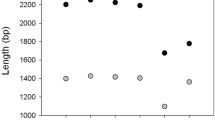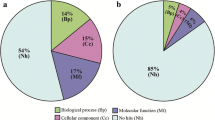Abstract
Karenia brevis (Davis) is the dinoflagellate responsible for nearly annual red tides in the Gulf of Mexico. Although the mechanisms regulating the growth and toxicity of this problematic organism are of considerable interest, little information is available on its molecular biology. We therefore constructed a complementary DNA library from which to gain insight into its expressed genome and to develop tools for studying its gene expression. Large-scale sequencing yielded 7001 high-quality expressed sequence tags (ESTs), which clustered into 5280 unique gene groups. The vast majority of genes expressed fell into a low-abundance class, with the highest expressed gene accounting for only 1% of the total ESTs. Approximately 29% of genes were found to have similarity to known sequences in other organisms after BLAST similarity comparisons to the GenBank public protein database using a cutoff of P < 10e−4. We identified for the first time in a dinoflagellate a suite of conserved eukaryotic genes involved in cell cycle control, intracellular signaling, and the transcription and translation machinery. At least 40% of gene clusters displayed single nucleotide polymorphisms, suggesting the presence of multiple gene copies. The average GC content of ESTs was 51%, with a slight preference for G or C in the third codon position (53.5%). The ESTs were used to develop an oligonucleotide microarray containing 4629 unique features and 3462 replicate probes. Microarray labeling has been optimized, and the microarray has been validated for probe specificity and reproducibility. This is the first information to be developed on the expressed genome of K. brevis and provides the basis from which to begin functional genomic studies on this harmful algal bloom species.





Similar content being viewed by others
References
Altschul SF, Gish W, Miller EW, Myers EW, Lipman DJ., (1990). Basic logical alignment search toolJ Mol Biol 215:403–410
Anderson DM, Grabher A, Herzog M., (1992). Separation of coding sequences from structural DNA in the dinoflagellate Crypthecodinium cohniiMol Mar Biol Biotech 1:89–96
Bachvaroff TS, Concepcion GT, Rogers CR, Herman EM, Delwiche CF., (2004). Dinoflgaellate expressed sequence tag data reveal massive transfer of chloroplast genes to the nuclear genomeProtist 155:65–78
Barbier M, Leighfield T, Soyer-Gobillard MO, Van Dolah FM., (2003). Permanent expression of a cyclin B homologue in the cell cycle of the dinoflagellate Karenia brevisJ Eukaryot Micro 50(2):123–131
Bhaud Y, Geraud M, Ausseil J, Soyer-Gobillard M, Moreu H., (1999). Cyclic expression of a nuclear protein in a dinoflagellateJ Eukaryot Microbiol 46(3):259–267
Boland MP, Taylor MFJR, Holmes CFB., (1993). Identification and characterization of a type-1 protein phosphatase from the okadaic acid producing marine dinoflagellate, Prorocentrum limaFEBS 334:13–17
Bundock PC, Christopher JT, Eggler P, Ablett G, Henry RJ, Holton TA., (2003). Single nucleotide polymorphisms in cytochrome P450 genes from barleyTheor Appl Genet 106:676–682
Chan KL, New D, Ghandhi S, Wong F, Lam CMC, Wong JTY., (2002). Transcript levels of the eukaryotic translation initiation factor 5A gene peak at early G1 phase of the cell cycle in the dinoflagellate Crypthecodinium cohniiAppl Environ Microbiol 68(5):2278–2284
Comolli J, Taylor W, Rehman J, Hastings JW., (1996). Inhibitors of serine/threonine phosphoprotein phosphatases alter circadian properties in Gonyaulax polyedraPlant Physiol 111:285–291
Dawson JF, Ostergaard HL, Klix H, Boland MP, Haoles CFB, (1997). Evidence for reversible tyrosine phosphorylation in the okadaic acid–producting dinoflagellate Prorocentrum limaJ Eukaryot Microbiol 44:89–95
Fast NM, Xue L, Bingham S, Keeling P., (2002). Re-examining aveolate evolution using multiple protein molecular phylogeniesJ Eukaryot Microbiol 49(1):30–37
Gardner MJ, Hall N, Fung E, White O, Berriman M, Hyman RW, Carlton JM, Pain A, Nelson KE, Bowman S, Paulsen IT, James K, Eisen JA, Rutherford K, Salzberg SL, Craig A, Kyes S, Chan MS, Nene V, Shallom SJ, Suh B, Peterson J, Angiuoli S, Pertea M, Allen J, Selengut J, Haft D, Mather MW, Vaidya AB, Martin DM, Fairlamb AH, Fraunholz MJ, Roos DS, Ralph SA, McFadden GI, Cummings LM, Subramanian GM, Mungall C, Venter JC, Carucci DJ, Hoffman SL, Newbold C, Davis RW, Fraser CM, Barrell B., (2002). Genome sequence of the human malaria parasite Plasmodium falciparumNature 419: 498–511
Geesey ME, Tester PA (1993) Gymnodinium breve: ubiquitous in Gulf of Mexico surface waters. In: Toxic Phytoplankton Blooms in the Sea, Proceedings of the Fifth International Conference on Toxic Marine Phytoplankton, Newport, Rhode Island, U.S.A, October 28 –November 1, 1991, Smayda TJ, Shimizu Y, eds. (Amsterdam: Elsevier Science Publishers), pp 251–25
Guillard RRL. (1973). Division rates. In: Stein J.R., (ed). Handbook of Phycological Methods — Culture Methods and Growth Measurements, Cambridge, U.K.: Cambridge University Press, 289–311
Guillebault D, Sasorith S, Derelle E, Wurtz JM, Lozano JC, Bingham S, Tora L, Moreau H. (2002). A new class of transcription initiation factors, intermediate between TATA box-binding proteins (TBPs) and TBP-like factors (TLFs), is present in the marine unicellular organism, the dinoflagellate Crypthecodinium cohniiJ Biol Chem 277(43):40881–40886
He C, Chen L, Simmoms M, Li P, Kim S, Liu ZJ., (2003). Putative SNP discovery in interspecific hybrids of catfish by comparative EST analysisAnim Genet 34:445–448
Jenny M, Ringwood AH, Lacy E, Lewitus AJ, Kempton JW, Gross PS, Warr GW, Chapman RW., (2002). Potential indicators of stress response identified by expressed sequences tag analysis of hemocytes and embryos from the American oyster, Crassostrea virginicaMar Biotechnol 4:81–93
Kamykowski D, Milligan EJ, Reed RE., (1998). Biochemical relationships in the orientation of the autotrophic dinoflagellate Gymnodinium breve under nutrient replete conditionsMar Ecol Prog Ser 167:105–117
Kim YS, Martin DF. (1974). Effects of salinity on synthesis of DNA, acidic polysaccharide and ichthyotoxin in Gymnodinium brevePhytochemistry 13:533–538
Kota R, Kumar VR, Thiel T, Dehmer K. J, Graner A., (2001). Generation and comparison of EST-derived SSRs and SNPs in barley (Hordeum vulgare L.)Hereditas 135:145–151
Kruze M, Muller IM, Muller WG., (1997). Early evolution of metazoan serine/threonine and tyrosine kinases: identification of selected kinases in spongesMol Biol Evol 14:1326–1334
Le QH, Markovic P, Hastings JW, Jovine RVM, Morse D. (1997). Structure and organization of the peridinin chlorophyll protein gene in Gonyaulax polyedra. Mol Gen Genet 255:595–604
Lee DH, Mittag M, Sczelan S, Morse D, Hastings J.W., (1993). Molecular cloning and genomic organization of a gene for luciferin-binding protein from the dinoflagellate Gonyaulax polyedra J Biol Chem 268:8842–8850
Leighfield TA, Barbier M, Van Dolah FM., (2002). Evidence for cAMP-dependant protein kinase in the dinoflagellate, Amphidinium operculatumComp Biochem Physiol 133B(3):317–324
Lew DJ, Dulic V, Reed SI., (1991). Isolation of three novel human cyclins by rescue of G1 cyclin (Cln) function in yeastCell 66:1197–1206
Lin S, Zhang H., (2003). Mitogen-activated protein kinase in Pfiesteria piscicida and its growth rate-related expressionAppl Environ Microbiol 69(1):343–349
Machabee S, Wall L, Morse D., (1994). Expression and genomic organization of a dinoflagellate gene familyPlant Molec Biol 25:23–31
Miller-Morey JS, Van Dolah FM., (2004). Differential responses of stress proteins, antioxidant enzymes, and photosynthetic efficiency to physiological stresses in the Florida red tide dinoflagellate, Karenia brevisComp Biochem Physiol C 138(4):493–505
Reichman JR, Thomas W, Peter V., (2003). PCP gene family in Symbiodinium from Hippopus hippopus: low levels of concerted evolution, isoform diversity, and spectral tuning of chromophoresMol Biol Evol 20(12):2143–2154
Rizzo PD., (1982). Isolation and properties of isolated nuclei from the Florida red tide dinoflagellate Gymnodinium breveJ Protozool 29:217–222
Rizzo PJ., (1979). RNA synthesis in isolated nuclei of the dinoflagellate Crypthecodinium cohniiJ Protozool 26:290–294
Rowan R, Whitney SM, Fowler A, Yellowlees D., (1996). Rubisco in marine symbiotic dinoflagellates: form II enzymes in eukaryotic oxygenic phototrophs encoded by a nuclear multigene familyPlant Cell 8:539–553
Salois P, Morse D., (1997). Characterization and molecular phylogeny of a protein kinase cDNA from the dinoflagellate GonyaulaxJ Phycol 33:1063–1072
Santos SR, Coffroth MA., (2003). Molecular genetic evidence that dinoflagellates belonging to the genus Symbiodinium Freudenthal are haploidBiol Bull 204:10–20
Sigee DC., (1984). Structural DNA and genetically active DNA in dinoflagellate chromosomes. Biosystems 16:203–210
Snyder RV, Gibbs PDL, Palacios A, Abiy L, Dickey R, Lopez JV, Rein KS., (2003). Polyketide synthase genes from marine dinoflagellatesMar Biotechnol 5(1):1–12
Sugg L, Van Dolah FM., (1999). No evidence for an allelopathic role of okadaic among ciguatera associated dinoflagellates. J Phycol 35:93–108
Triplett EL, Govind NS, Roman SJ, Jovine RVM, Prezelin BB., (1993). Characterization of the sequence organization of DNA from the dinoflagellate Heterocapsa pygmaea (Glenodinium sp.)Mol Mar Biol Biotechnol 2(4):239–245
Van Dolah FM, Leighfield TA., (1999). Diel phasing of the cell cycle in the Florida red tide dinoflagellate, Gymnodinium breveJ Phycol 35S:1404–1411
Walker LM., (1982). Evidence for a sexual cycle in the Florida red tide dinoflagellate Ptychodiscus brevis (=Gymnodinium breve)Bioscience 32:809–810
Wong JTY, Leveson A, Wong F., (1997). Cyclins in a dinoflagellate cell cycle Mol Mar Biol Biotechnol 6(3):172–179
Yeung PKK, New D, Leveson A, Yam C, Poon P, Wong J., (2000). The spindle checkpoint in the dinoflagellate Crypthecodinium cohniiExp Cell Res 254:120–129
Acknowledgments
We thank Jeral Tyler and Bennie Haynes for laboratory assistance, Jeanine Miller-Morey for culture maintenance, and Paul Gross for use of the Qiagen Biobot 9600 system. EST sequencing was performed by Seqwright, Houston, Texas. Funding for this project was provided by NOAA programmatic funding for Marine Biotoxins and ECOHAB grants ECO-01-242 and NA03NOS478 to F.M.V.D.
Author information
Authors and Affiliations
Corresponding author
Rights and permissions
About this article
Cite this article
Lidie, K.B., Ryan, J.C., Barbier, M. et al. Gene Expression in Florida Red Tide Dinoflagellate Karenia brevis: Analysis of an Expressed Sequence Tag Library and Development of DNA Microarray. Mar Biotechnol 7, 481–493 (2005). https://doi.org/10.1007/s10126-004-4110-6
Received:
Accepted:
Published:
Issue Date:
DOI: https://doi.org/10.1007/s10126-004-4110-6




